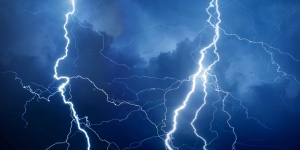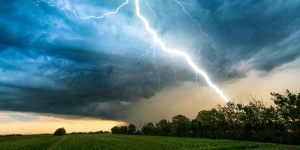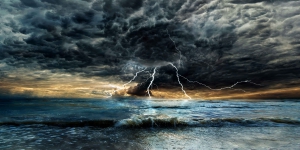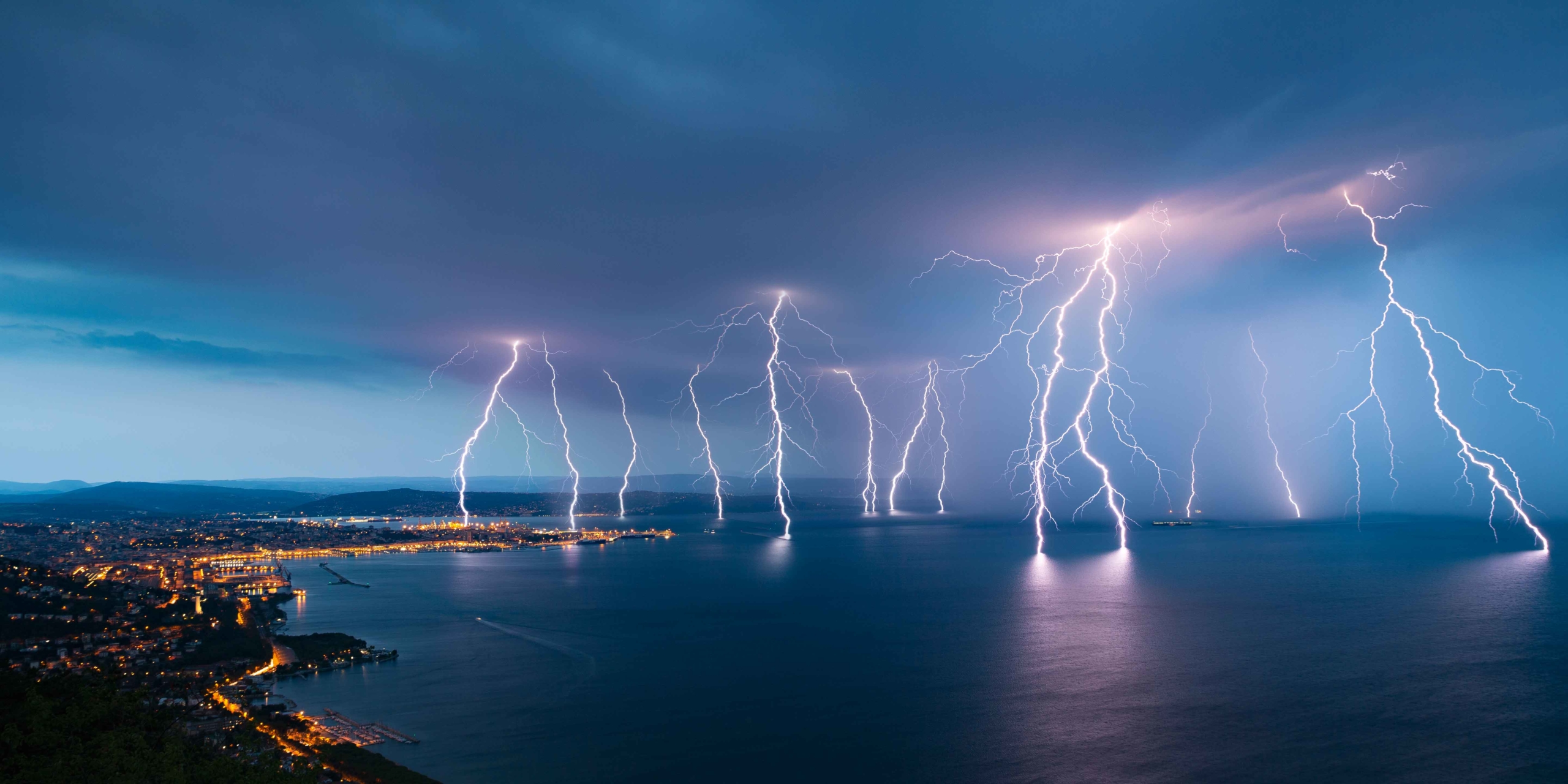Patients struck by lightning are certainly not common emergencies, especially not on the West Coast.
In San Francisco, lightning is so rare that if it does occur it makes the news. People from the Midwest and Southwest — especially those in tornado alley — find it making the news rather strange.
Florida has the highest rate of lightning strikes per year in the nation. The actual incidence of lightning strikes is second only to flooding in weather-related causes of death, injury and property damage.
Lightning strikes are responsible for about 24,000 fatalities and about 10 times as many injuries worldwide each year. Lightning also is responsible for about 75,000 forest fires — California being an exception since most wildfires there are of human origin — and 40% of all fires.
To put this in perspective, cloud-to-ground strikes occur some 20 million times a year worldwide with 50,000 flashes per hour.
You can understand why the worldwide estimate of damage, injury and death may well be underestimated as many strikes in remote areas go unreported for obvious reasons.
Sometimes victims of lightning strikes do not survive. If they do, they may not be fully aware of what happened. Fire investigation also isn’t a high priority in such areas.
However, in rural settings the threat is greater because of the outdoor lifestyle of the area. Lightning safety education and lightning-safe engineering prove less common in rural areas, as well.
Lightning myths debunked
 People often have a colloquial understanding that often has some basis in fact or at least in experience and practical application.
People often have a colloquial understanding that often has some basis in fact or at least in experience and practical application.
An example of a saying is: “Don’t work outdoors in a thunderstorm.” That is tantamount to what mom always said: “Come in out of the rain.”
There are quite a few myths about lightning. Some European friends told me that opening the front and back door of your house during a thunderstorm attracts lightning.
Yet these same people were perfectly comfortable standing on a balcony leaning on a metal railing during a thunderstorm.
Here are some common myths and misconceptions:
- Talking on a cell phone or using an iPod in a thunderstorm will attract lightning. Spoiler alert: It won’t. These devices will affect the flow of electricity should lightning strike someone. But to conduct a lightning charge, the device has to be hard wired.
- Rubber-soled shoes will protect you against a lightning strike. They won’t.
- Wearing metal jewelry will attract lightning. False.
- If you stand on one foot, lightning will not pass through you because there is only one contact point with the ground, therefore, an incomplete circuit. This is not true.
- Lightning never strikes twice in the same place. This is my all-time favorite because in a typical single millisecond strike, there are often as many as 20 return flashes and some sustained strikes can last several seconds.
Types of lightning strikes
There are several forms of lightning, some of which are not dangerous at all, such as cloud-to-cloud flashes which account for 70% to 90% of all lightning.
There also is sheet lightning, red sprites, blue jets and elves. These forms occur far above the earth and pose no danger and, for the most part, are unseen with the exceptions of cloud-to-cloud or sheet lightning, according to the National Severe Storms Laboratory.
Other forms are less dangerous, such as the Cooper upward streamers in which the flash travels upward from the ground but does not connect with a downward streamer. The voltage is much less, however, and it will pass through (or over) a person who happens to be where it occurs.
The most dangerous form of lightning that causes the most death and destruction is the cloud-to-ground strike, which accounts for 10% to 30% of all cases. In this type of lightning a negatively charged channel — called a step leader — develops in, and emerges from, a cloud in a zigzag pattern to the ground in less than a fraction of a second.
Where lightning strikes
Cloud-to-ground strikes are invisible as they near the ground and are attracted to a positive charge emanating up from the ground, such as an object like a tower, pole, tree or person.
There is no evidence to support the notion that a taller object in the area will attract the lightning. It seems to connect with a ground charge in random fashion because of mechanisms not fully understood, according to the Medscape article, “Lightning Injuries.”
Often there are multiple points of contact owing to multiple branches of the step leader. When these opposite charges meet, a circuit is completed and the return bolt flashes back to the cloud at about 60,000 miles per second, according to the National Severe Storms Laboratory.
The appearance is that the bolt came from the cloud, but in fact its origin is from the ground. However, the multiple return flashes that give lightning its zigzagged appearance are what we actually see.
So it is two types — cloud-to-ground lightning and upward streamers — and their variants that cause injury, damage and death.
When lightning hits a human
 Direct strike is by far the most devastating to people and property. But let’s look specifically at the injury pattern to humans. About 9% of people struck die as a result of the lightning itself.
Direct strike is by far the most devastating to people and property. But let’s look specifically at the injury pattern to humans. About 9% of people struck die as a result of the lightning itself.
Fewer than 5% of all strikes are direct and of those, most are instantaneous exposures lasting milliseconds. Some strikes contain multiple flashes and can sustain themselves for as long as 0.5 seconds.
Injuries can range from mild static electricity-like exposures to cardiac arrest. Although rare, deep burn injuries also can occur. Most burns are superficial.
However, the most significant injuries are multi-system involving the nervous system, cardiac and respiratory function. Blunt trauma concussive injuries from a blast wave or penetrating injuries from shrapnel also can occur.
Keranuoparalsys is a lightning-specific injury manifested by transient weakness and/or paralysis of the limbs, often resulting in immobility, which may predispose a person to secondary injury such as fire, according to Medscape article, “Lightning Injuries” and the Journal of Craniovertebral Junction & Spine.
Lightning strike injuries are classified into mild, moderate and severe
- Mild injuries rarely cause even superficial burns, but the victim often will sustain a loss of consciousness, amnesia, paresthesia and numbness. When burns do occur, they are superficial. These patients seldom require hospitalization and are often treated and released.
- Moderate injuries may cause seizures, respiratory arrest and cardiac standstill, which spontaneously resolves as the heart resumes its normal rhythm. However, because of paralysis, respiratory failure persists and can lead to hypoxia and subsequent cardiac arrest. For this reason, in cases of multiple victims, triage is reversed as the cardio-pulmonary arrest resolves into only respiratory arrest and is treatable by BLS techniques with good prognosis. Superficial burns are more common, and these patients may experience lifelong neurological symptoms and chronic pain. Yet the need for hospitalization is based on obvious physical injuries and the need for observation for complications. In the acute phase, cardiac standstill most often (but not always) resolves. However, as with mild cases, the resultant respiratory arrest will lead to hypoxia if not treated promptly and subsequently into cardiac arrest again.
- Severe injuries may sustain burns and usually present in cardiopulmonary arrest that is not self-resolving. However, CPR is still indicated as is the concept of reverse triage. Remember this environment may still present a lightning hazard.
A fourth category of lightning injuries also exists. It is the effects of trauma, such as burns secondary to the lightning. Entry and exit wounds may be present, especially with sustained strikes. Myoglobinuria and subsequent kidney failure and multiple organ failure also may be present, according to the Journal of Craniovertebral Junction & Spine.
Sustaining high voltage
Lightning is not comparable to household or industrial high voltage for several reasons.
- The exposure time with lightning is usually milliseconds.
- Victims sustain high voltage contact .
- Exposure makes a big difference.
Industrial current is alternating current while lightning is direct current. There is a low incidence of traumatic electrical injury, or injury in general because of the flow of electricity in lightning. There is quite often transient or permanent neurological injury and damage.
AC industrial current travels through the body whereas lightning (electricity in general) follows the path of least resistance. Lightning will “flash over “a victim (the path of least resistance). This may vaporize sweat or water on the person’s body resulting in steam burns and often blowing clothes off.
Industrial current also follows the path of least resistance, but it is quite a different path. It enters the body and flows along the bones causing deep burn injuries and exits because the current contacts at one point and then goes to ground.
Exposure time plays a role in the injury pattern as well. With generated electricity, exposure time allows for the generation of a significant amount of heat.
Lightning is on the order of milliseconds while industrial or house electricity continues to flow as long as there is contact completing the circuit. Generated electricity is a voltage phenomenon whereas lightning is a current phenomenon. Once the pathway to ground is completed, the voltage goes to zero, according to Medscape.
Types of lightning strikes on humans
When lightning strikes a person, it can make contact in several different ways, such as:
- Direct accounts for 3% to 5% of injuries. These are not necessarily fatal. Only about 9% of people struck directly die.
- Upward leader accounts for anywhere from 15% to 20% of injuries. This type is generally of a lower voltage, although that is relative considering the average bolt is about 30 million volts.
- Contact voltage from being in contact with a lightning-charged object. Hard-wired appliances such as computers, land line phones, plumbing or any other object that is struck or in contact with the object struck. This accounts only for 1% to 2% of injuries.
- Side splash is when the charge strikes an object and “splashes” sideways to another object. This accounts for about 30% of injuries.
- Ground current effect is when the current spreads out across the ground. As it comes in contact with that person, it passes through the person because the human body offers less resistance than the ground. Most injuries — 40% to 50% — are from this type and side splash, according to the National Severe Storms Laboratory.
A tragic story
 Probably one or a combination of these last two was responsible for an incident in the Democratic Republic of Congo during a soccer match between Basanga and the home team, BenaTshadi, in 1998.
Probably one or a combination of these last two was responsible for an incident in the Democratic Republic of Congo during a soccer match between Basanga and the home team, BenaTshadi, in 1998.
At the half, the score was 1-1 when another phenomenon of lightning occurred. This is clear sky or blue-sky lightning, which is a freak occurrence where lightning can strike after a thunderstorm has passed up to 10 miles away.
This gives rise to the expression, “out of the blue or a bolt from the blue.” In this case, the tragic result was 11 dead — oddly enough only on the visiting team — with 30 fans sustaining burn injuries, according to The Guardian article. The heat generated by a lightning bolt can reach 15,000 degrees.
This is not the only case of lightning striking soccer players. Across Africa, other instances have occurred. Just days before the Democratic Republic of Congo tragedy, lightning knocked several soccer players and a referee to the ground in South Africa without serious injury or death.
Snow Lightning
There is also a phenomenon known as snow lightning, which is lightning during a snowstorm. Extremely rare and only accounting for about 1% of all snowstorms, snow lighting can produce all of the above-mentioned strikes during a “thundersnow” storm.
This type of storm tends to precede whiteout conditions, remain stationary and drop large amounts of snow in a short period.
Riding a ski lift is especially dangerous during snow lightning for several reasons:
- You can’t get off.
- The electricity (running the lift) goes out, leaving you stuck.
- Lifts are usually made of metal and in contact with numerous strike points.
Mountain climbers also are at risk because thundersnow is more likely in mountainous terrain, according to an article in the Scientific American.
Exposure to lightning
Lightning is unpredictable in its effect on people because of its variable charge and flow of current. Flash over is responsible for seemingly minor physical and electrical injuries.
Exposure is a factor in sustained strikes — one lasting over a few milliseconds— because a lot of energy is absorbed. This causes the object or person to explode or sustain serious burns. This is uncommon, but most injuries are neurological and can be lifelong and debilitating.
Lightning strikes often result in superficial burns, mental status changes, tympanic rupture and eye injuries. Concussions and blunt force (blast wave) injuries also are common results. Most victims survive, but long-term prognoses is unknown because of a lack of research in this area, according to Medscape article, “Lightning Injuries.”
Our treatment is focused on life threats. Multiple victims in respiratory and/or cardiac arrest would necessitate a multi-unit response.
In the South African instance mentioned earlier, the fans, onsite medics and other teammates responded and no serious injuries or deaths occurred.
In the Democratic Republic of Congo incident, people fled fearing supernatural reprisal. The lack of immediate assistance and resuscitation may have accounted for the high death toll.

